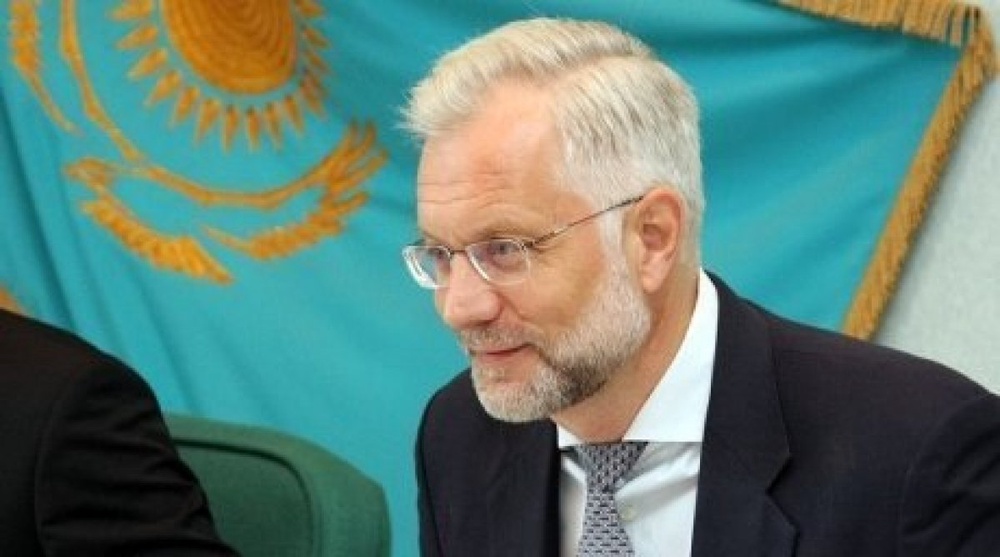
In an interview for Russia’s http://www.1prime.ru August7, 2012, Kazakhstan Central Bank Governor Gregory Marchenko commented on the recent slashing down the key rate. According to him, the inflation rate for the recent 12 months stands at 4.7% (…). With the exception of the inflation hike back in 2007-2008 – due to the surge of global prices for foodstuffs and energy – the average yearly inflation for the last 10-12 years has been standing at 7.3%. (…) Slashing down the key rate to 5.5% (starting from August 6), the National Bank compels the banking sector to cut down interest rates on loans and deposits. The only exception to the overall trend [of slowing inflation] is the growing price for grain: for the recent month the indicator has mounted from $230 to $330 per ton. We do understand that this factor will have an adverse effect on prices for foodstuffs that account for 38% of the market basket of consumer goods. Mr. Marchenko elaborated that so far the National Bank has no plans to revisit the anticipated inflation corridor of 6-8% downwards for the following year. He added that the data on inflation tallied by the State Agency for Statistics have been monitored by the IMF once every two years. Kazakhstan’s National Bank slashed the key rate from the current 6% to 5.5% starting from August 6, KazTag Agency reports, citing the regulator’s press service. In the H1 2012 Kazakhstan slashed its key rate three times: in February from 7.5% to 7%, in April from 7% to 6.5% and in June from 6.5% to 6%. The key rate is the interest rate at which an eligible financial institution may borrow funds directly from the National (Central Bank). The National Bank uses the key rate to control the supply of available funds, which in turn influences inflation and overall interest rates. The more money available, the more likely inflation will occur. Raising the rate makes it more expensive to borrow from the National Bank. That lowers the supply of available money, which increases the short-term interest rates. Lowering the rate has the opposite effect, bringing short-term interest rates down.





In an interview for Russia’s http://www.1prime.ru August7, 2012, Kazakhstan Central Bank Governor Gregory Marchenko commented on the recent slashing down the key rate.
According to him, the inflation rate for the recent 12 months stands at 4.7% (…). With the exception of the inflation hike back in 2007-2008 – due to the surge of global prices for foodstuffs and energy – the average yearly inflation for the last 10-12 years has been standing at 7.3%. (…) Slashing down the key rate to 5.5% (starting from August 6), the National Bank compels the banking sector to cut down interest rates on loans and deposits. The only exception to the overall trend [of slowing inflation] is the growing price for grain: for the recent month the indicator has mounted from $230 to $330 per ton. We do understand that this factor will have an adverse effect on prices for foodstuffs that account for 38% of the market basket of consumer goods.
Mr. Marchenko elaborated that so far the National Bank has no plans to revisit the anticipated inflation corridor of 6-8% downwards for the following year. He added that the data on inflation tallied by the State Agency for Statistics have been monitored by the IMF once every two years.
Kazakhstan’s National Bank slashed the key rate from the current 6% to 5.5% starting from August 6, KazTag Agency reports, citing the regulator’s press service.
In the H1 2012 Kazakhstan slashed its key rate three times: in February from 7.5% to 7%, in April from 7% to 6.5% and in June from 6.5% to 6%.
The key rate is the interest rate at which an eligible financial institution may borrow funds directly from the National (Central Bank). The National Bank uses the key rate to control the supply of available funds, which in turn influences inflation and overall interest rates. The more money available, the more likely inflation will occur. Raising the rate makes it more expensive to borrow from the National Bank. That lowers the supply of available money, which increases the short-term interest rates. Lowering the rate has the opposite effect, bringing short-term interest rates down.


 +7 (777) 001 44 99
+7 (777) 001 44 99















































